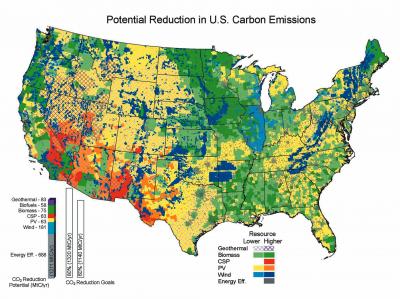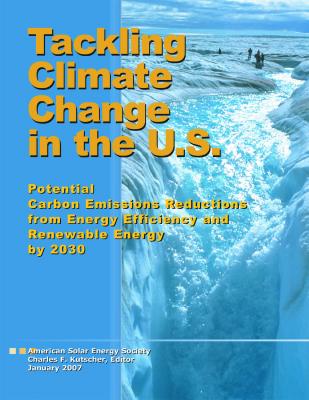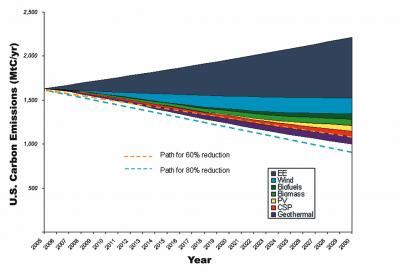As scientists sound daily alarms about the dire consequences of global warming, Americans are asking one question: What can we do about it? The American Solar Energy Society (ASES) has an answer: Deploy clean energy efficiency and renewable energy technologies now!
On Wednesday morning, January 31, 2007 at a press conference in Washington, D.C., ASES unveiled a 200-page report (pdf), Tackling Climate Change in the U.S.: Potential Carbon Emissions Reductions from Energy Efficiency and Renewable Energy by 2030. The result of more than a year of study, the report illustrates how energy efficiency and renewable energy technologies can provide the emissions reductions required to address global warming. The report tackles everything from solar and wind power, to how plug in hybrid cars and energy efficiency will help us to reduce our GHG emissions. The report methodically illustrates the steps needed to tackle this crisis here in the United States.

This U.S. map shows how the various renewable technologies can be deployed around the country. The bar graph on the lower left shows the potential contributions each technology area can make (in terms of carbon displacements in millions of tons of carbon per year in 2030), compared to what will be needed by 2030 to be on the path to achieve reductions of 60% to 80% below today’s levels by mid-century—the target range given by many scientists. Many locations have multiple resources, which cannot be adequately delineated on one map, but separate U.S. maps for each renewable resource are presented in the report.
The press event included remarks from report editor Chuck Kutscher, ASES Executive Director Brad Collins, National Aeronautics and Space Administration (NASA) climate scientist James Hansen, Sierra Club Executive Director Carl Pope, Senator Jeff Bingaman, and Congressmen Henry Waxman and Christopher Shays. According to Hansen, “We must begin fundamental changes in our energy use now in order to avoid human-made climate disasters.”
To develop the report, ASES recruited a volunteer team of top energy experts. These experts produced a series of nine papers that examined how energy efficiency and renewable energy technologies can reduce U.S. carbon dioxide emissions-the main cause of global warming.
ASES collected the nine papers together and added an overview of the studies to create the report. It covers energy efficiency in buildings, transportation, and industry, as well as six renewable energy technologies: concentrating solar power, photovoltaics, wind power, biomass, biofuels, and geothermal power. The results indicate that these technologies can displace approximately 1.2 billion tons of carbon emissions annually by the year 2030-the magnitude of reduction that scientists believe is necessary to prevent the most dangerous consequences of climate change.
This graph (using the mid-range values of estimates) shows seven "wedges" representing (from the top down) the U.S. carbon displacement potentials by 2030 (the target year for this study) for energy efficiency, wind power, biofuels, biomass, photovoltaics, concentrating solar power, and geothermal power. Also shown are the paths needed to achieve 60% and 80% reductions below today’s emissions by mid-century—the target range given by many scientists. Energy efficiency measures alone have the potential to keep our nation’s carbon emissions roughly constant over the next 24 years as our economy grows. The various renewable technologies have the potential to make the deep cuts below today’s emissions that scientists believe are needed.
The report illustrates how energy efficiency measures could keep U.S. carbon emissions roughly constant over the next 23 years as the economy grows, and how renewable energy technologies could make deep cuts below today’s emissions. Wind energy provides about 35% of the renewable energy contribution, while the rest is divided about evenly among the other technologies. “Energy efficiency and renewable energy technologies can begin to be deployed on a large scale today to help save us from the worst consequences of global warming,” said Kutscher. “With continued R&D to lower costs and a reasonable level of policy support, they have the potential to meet most, if not all, of the carbon reductions that will be required in the future.”


What will we do with all the methane the planet
farts?
CO2 is a pipsqueak in comparison.
Sorry…
the correct link above.
Solar is clean, renewable, sustainable, abundant, & quiet.
now it is affordable too.
Join The Solar Solution
Homeowners: Switch to Solar Power the EASY Way
http://www.JoinTheSolution.com/MadiSUN
I didn’t see where they talk about how much electricity is being genreated. This tons of carbon stuff just confuses me.
Jomama: While its true that methane is a much more effective green house gas the massive amount of co2 being released dwarfs methane.
There is something to be said for targeting gases like methane and other very effective green house gasses, as you get more “bang for your buck” stopping x amount of methane from being released is like stopping x(y) amounts of co2. But the problem is that it is often impossible to stop sources of methane (they occur naturally) it is however very possible to limit the amount of co2 that is pumped out.
Hope this helps.